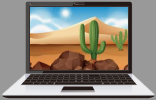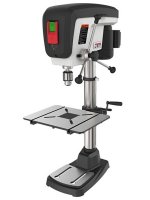

▸ Drill Presses: Get the Hole Story~ by David Wall - in association with Amazon.comWhen it comes to making holes of a uniform angle and depth in wood, metal, and synthetics, you just can't beat a drill press. Sure, you can bumble along with a hand-held drill for less money, but craftspeople who aim to make top-quality products need the consistency that only a drill press can provide. Among drill presses, you'll find two basic classes of equipment: |
 (A) Bench Top Drill Presses:Use these presses for smaller jobs; they are meant to be bolted or clamped to the top of a bench or stand.(B) Floor Model Drill Presses:These presses are bigger, freestanding machines. They have bases that sit directly on the floor of your shop and extend upward so you can comfortably manipulate the tool while sitting on a high stool or standing. |
▸ Check the Specs |
 When buying a drill press, carefully read the product descriptions to find out how any model you're considering stacks up to the following specifications: When buying a drill press, carefully read the product descriptions to find out how any model you're considering stacks up to the following specifications:
1. Electric Motor: Drill presses run on electric motors rated in horsepower. Make sure the motor in the model you choose is powerful enough for the work you do. Bench drill presses typically have motors rated between .3 hp and .5 hp. Floor drill presses have motors rated between .75 hp and 1.5 hp. Choose the highest power rating you can afford, because on any given job a more powerful motor will be less strained and will therefore last longer. 2. Speed control: You'll want to adjust the speed at which your bits spin to suit different materials. Drill presses typically allow you to vary the spin rate between about 500 rpm (revolutions per minute) and 3500 rpm. Some provide a series of specific speed settings (such as 500, 1000, 1500, 2000, 2500, and 3500 rpm), which is fine for most applications. Fancier models may feature continuously variable electronic speed controls. |
| 3. Throat depth: Because of their design, drill presses are limited by the distance between the center of the spindle (where the bit goes) and front edge of the vertical post that supports the drill head--a measurement called throat depth. If you want to drill a hole in the center of a round workpiece such as a tabletop, the radius of the workpiece must be less than the throat depth. |
| 4. Spindle travel: The spindle of a drill press moves up and down only so far. This range of motion is called spindle travel, and it determines the maximum depth of the holes you can bore. |
 5. Table adjustments: 5. Table adjustments:Most drill presses have a tilting worktable--some tilt 45° left and 45° right while others can tilt a full 90° in each direction. Make sure the drill press you buy can handle the kinds of angles you work with. The table should swing in the horizontal plane, too--good ones can spin completely around the post. 6. Head adjustments: Some drill presses supplement a tilting table with a tilting drill head. Tilting heads typically move 45° left and right, and ease the mind-bending work of compound angles. With tilting heads and tilting tables, make sure you're comfortable with both the adjustment mechanism and the angle gauge. |
▸ Look for Goodies |
 A lot of drill presses come with a selection of bits. Bits aren't expensive in comparison to drill presses, but you do need them to get started. If you already own a bit for a hand-held drill, you can use it for the same application in a drill press. A lot of drill presses come with a selection of bits. Bits aren't expensive in comparison to drill presses, but you do need them to get started. If you already own a bit for a hand-held drill, you can use it for the same application in a drill press.
You might want to pick up some accessories that take advantage of a drill press's accuracy and stability. Experiment with rosette knives for creating decorative moldings or other Drill Press Attachments. Look into vises and clamps specifically designed for your drill press worktable. ▸ David Wall is the author of several books on Java and the Internet. |